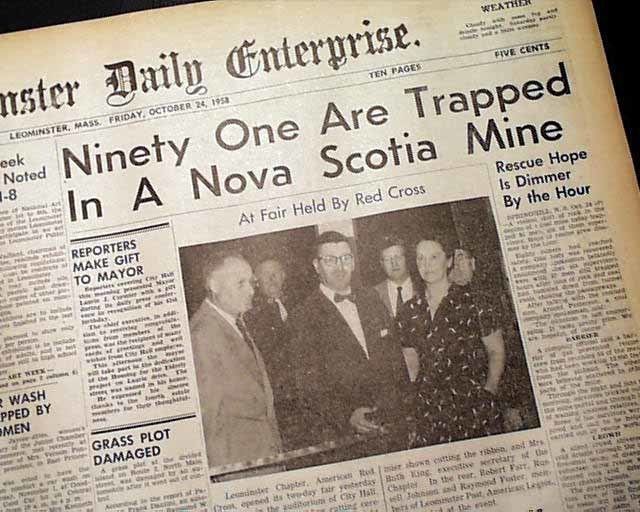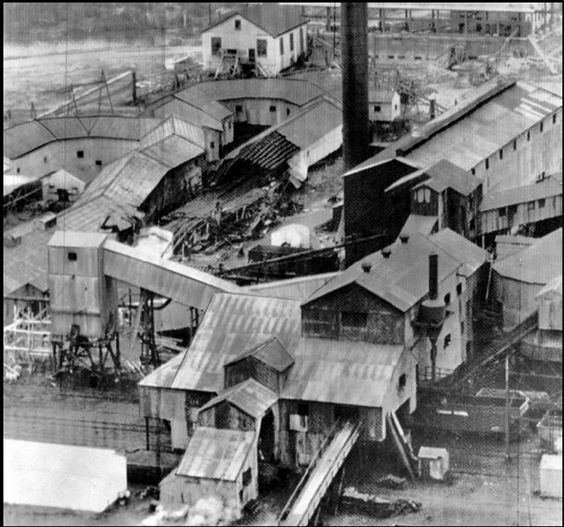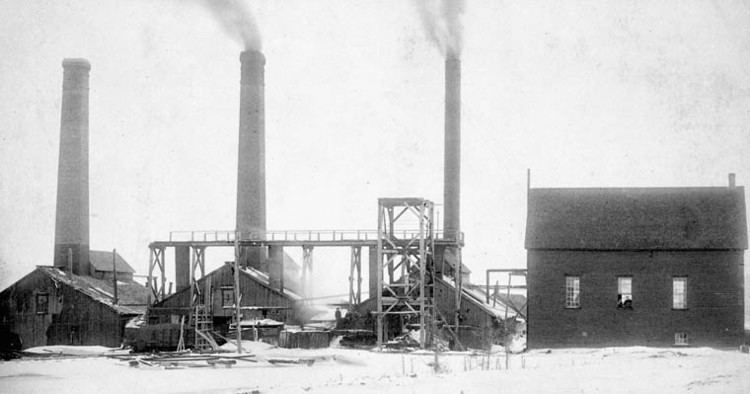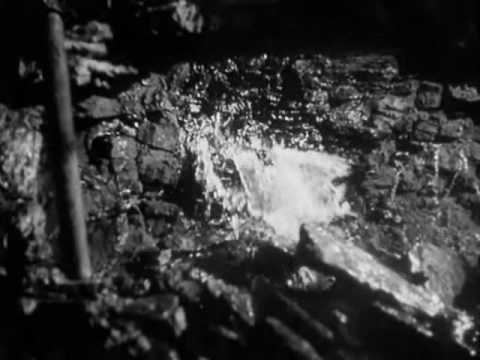Period 1891 – 1958 | ||
 | ||
Similar Hillcrest mine disaster, 1909 Cherry Mine disa, Farmington Mine disaster, Halifax Explosion, Monongah mining disaster | ||
Springhill mining disaster collapsing mine tragedy
Springhill mining disaster may refer to any of three Canadian mining disasters that occurred in 1891, 1956, and 1958 in different mines within the Springhill coalfield, near the town of Springhill in Cumberland County, Nova Scotia.
Contents
- Springhill mining disaster collapsing mine tragedy
- Rare u2 springhill mining disaster live from dublin
- 1891 explosion
- 1956 explosion
- The events
- The aftermath
- Representations in popular culture
- References

The mines in the Springhill coalfield were established in the 19th century, and by the early 1880s were being worked by the Cumberland Coal & Railway Company Ltd. and the Springhill & Parrsboro Coal & Railway Company Ltd. These entities merged in 1884 to form the Cumberland Railway & Coal Company Ltd., which its investors sold in 1910 to the industrial conglomerate Dominion Coal Company Ltd. (DOMCO). Following the third disaster in 1958, the operator Dominion Steel & Coal Corporation Ltd. (DOSCO), then a subsidiary of the A.V. Roe Canada Company Ltd., shut its mining operations in Springhill, and they were never reopened. As of 2015 the mine properties, among the deepest works in the world and filled with water, are owned by the government of Nova Scotia, and provide Springhill's industrial park with geothermal heating.

Rare u2 springhill mining disaster live from dublin
1891 explosion

Springhill's first mining disaster, the 1891 explosion, occurred at approximately 12:30 pm on Saturday, February 21, 1891, in the Number 1 and Number 2 collieries, which were joined by a connecting tunnel at the 1,300-foot (400 m) level (below the surface) when a fire caused by accumulated coal dust swept through both shafts, killing 125 miners and injuring dozens more. Some of the victims were 10 to 13 years old.

Rescue efforts throughout that afternoon and evening were made easier by the lack of fire in No. 1 and No. 2, but the scale of the disaster was unprecedented in Nova Scotian or Canadian mining history, and the subsequent relief funds saw contributions come in from across the country and the British Empire, including Queen Victoria.
A subsequent inquiry determined that sufficient gas detectors in working order had been present in the two collieries; however, the ignition source of the explosion was never determined, despite investigators having pinpointed its general location.

The song "La Mine" (allegedly traditional) by the French Canadian folk group Le Vent du Nord on their 2009 album La part du feu relates to the 1891 explosion.
1956 explosion
The 1956 explosion occurred on November 1, 1956, when a mine train hauling a load of fine coal dust up to the surface of the 25-year-old Number 4 colliery to remove it from the pithead encountered a heavy flow of ventilation air being forced down the shaft by surface fans. The flow of air disturbed the dust on the ascending train cars and spread throughout the air of the shafts of No. 4. Before the train reached the surface, several cars broke loose and ran back down the slope of No. 4, derailing along the way and hitting a power line, causing it to arc and ignite the coal dust at the 5,500-foot (1,700 m) level (below surface).
The resulting explosion blew the slope up to the surface where the additional oxygen created a huge blast, which leveled the bankhead on the surface - where the coal is hauled out from the mine in an angled shaft into a vertical building (the coal is then dropped into railway cars). Most of the devastation was sustained by the surface buildings, but many miners were trapped in the shaft along with the derailed train cars and fallen support timbers and other items damaged by the explosion.
Heroically, Drägermen (rescue miners with breathing equipment) and barefaced miners (without such protection) entered the 6,100-foot-deep (1,900 m) No. 4 to aid their colleagues. 39 miners died, and 88 were rescued. Media coverage of the 1956 explosion was largely overshadowed by the Soviet invasion of Hungary and the Suez Crisis, which happened at about the same time. Nevertheless, Canadian and local media gave extensive coverage to the 1956 disaster.
After the rescue effort, the connected No. 4 and No. 2 collieries were sealed for several months to deprive the fires of oxygen. In January 1957, the bodies of the remaining casualties were recovered from the pit, and No. 4 colliery closed forever.
The events
The 1958 bump, which occurred on October 23, 1958, was the most severe "bump" (underground earthquake) in North American mining history. The 1958 bump devastated the people of Springhill for the casualties they suffered; it also devastated the town, as the coal industry had been its economic lifeblood.
It is not exactly known what causes a "bump". It could be the result of coal being totally removed from a bedrock unit or "stratum". The resulting geological stresses upon overlying strata (sandstone, shale, etc., in many coal-bearing formations) may cause the pillars (coal left in place to support the galleries) to suddenly and catastrophically disintegrate, so that the galleries themselves collapse.
No. 2 colliery was one of the deepest coal mines in the world. Sloping shafts 14,200 feet (4,300 m) in length led to a vast labyrinth of galleries more than 4,000 feet (1,200 m) below the surface. Mining techniques there had been changed 20 years before the 1958 bump, from "room and pillar" to "long wall retreating" after reports had shown the increased danger of "bump" phenomena resulting from the former technique.
On October 23 a small bump occurred at 7:00 pm during the evening shift; it was ignored, as this was a somewhat common occurrence. However, just over an hour later, at 8:06 pm, an enormous bump "severely impacted the middle of the three walls that were being mined and the ends of the four levels nearest the walls".
The bump spread as three distinct shock waves, resembling a small earthquake throughout the region, alerting residents on the surface over a wide area to the disaster. "Dräger" teams and teams of barefaced miners entered No. 2 colliery to begin the rescue effort. They encountered survivors at the 13,400-foot (4,100 m) level walking or limping toward the surface. Gas released by the bump was encountered in increasing concentrations at the 13,800-foot (4,200 m) level where the ceiling had collapsed, and rescuers were forced to work down shafts that were in a partial state of collapse or were blocked completely by debris.
Miners not saved by being either in side galleries or some other shelter were immediately crushed during the bump, the coal galleries and faces being completely destroyed. 75 survivors were on the surface by 4:00 am on October 24, 1958. Rescue teams continued working, but the number of rockfalls and the amount of debris slowed progress.
Meanwhile, the Canadian and international news media had made their way to Springhill. Arnie Pattersonwas the public relations spokesman for the Company, and relayed news of the progress of rescue (and later recovery) to the families of the miners and to reporters. The disaster became famous for being the first major international event to appear in live television broadcasts (on the CBC). As the world waited and those on the surface kept their vigil, rescuers continued to toil below ground trying to reach trapped survivors. Teams began to arrive from other coal mines in Cumberland County, on Cape Breton Island and in Pictou County.
After five and a half days (therefore around the morning of Wednesday, October 29, 1958), contact was established with a group of 12 survivors on the other side of a 160-foot (49 m) rockfall. A rescue tunnel was dug; it broke through to the trapped miners at 2:25 am on Thursday, October 30, 1958.
On Friday, October 31, 1958, the rescue site was visited by various dignitaries, including the Premier of Nova Scotia, Robert Stanfield, and His Royal Highness Prince Philip, the Duke of Edinburgh who had been at meetings in Ottawa.
On Saturday, November 1, 1958, another group of survivors was found. None were found thereafter. Instead, bodies of the dead were hauled out in airtight aluminum coffins, on account of the advanced stage of decomposition, accelerated by the Earth's heat in the depths of No. 2 mine at 13,000–14,000 feet (4,000–4,300 m) below the mine entrance.
Of the 174 miners in No. 2 colliery at the time of the bump: 75 died, and 99 were trapped but rescued.
The aftermath
The 1958 bump had profound and long-lasting effects on the town and on the public imagination.
In the media crush at the pithead (the shaft entrance at the surface), reporters rushed to speak with survivors, particularly the two groups of miners who had been trapped until Thursday and Sunday respectively. When asked what he wanted most, survivor Douglas Jewkes replied, "A 7 Up". Following this high-profile media event and unexpected "plug", the 7 Up company hired him as a spokesman.
Several miners and their rescuers were invited onto The Ed Sullivan Show. One miner, Maurice Ruddick, was chosen as Canada's "Citizen of the Year". Ruddick and the other "miracle miners" enjoyed public attention for a brief time after their rescue. For Ruddick, the only black man in the group, racism dimmed his moment in the spotlight. An aide to the Governor of the U.S. state of Georgia Marvin Griffin took advantage of the intense media coverage to promote tourism to that state by offering a group of survivors free vacations to Jekyll Island. However to the segregationist governor's chagrin (he had been vacationing on a hunting trip in Manitoba at the time of the disaster), he learned of Ruddick's race – which resulted in a public relations nightmare. Upon learning that Ruddick was black, the governor said that Ruddick would have to be segregated. Ruddick agreed to the governor's terms so that the other miners' vacations would not be ruined; but he and his family stayed in a trailer apart from his colleagues. Ruddick died in 1988. In 2003, U.S. author Melissa Fay Greene retold this aspect of the aftermath in her book Last Man Out.
The rescuers were awarded a Gold Medal by the Royal Canadian Humane Association for bravery in lifesaving, the first time the medal had been awarded to a group. In 1958, the town of Springhill was awarded the Carnegie Medal for Heroism recognizing the community involvement needed to save the surviving miners. As of 2015, Springhill is the only community to have received that award, usually reserved for individual acts of heroism.
